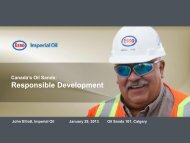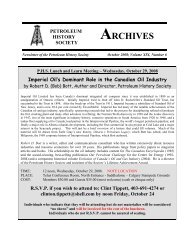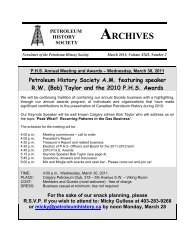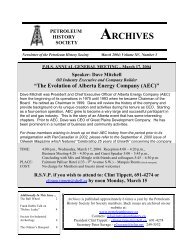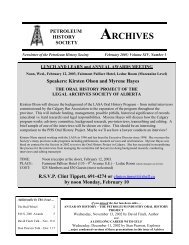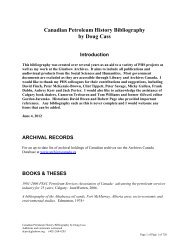PDF format - The Petroleum History Society of Canada
PDF format - The Petroleum History Society of Canada
PDF format - The Petroleum History Society of Canada
Create successful ePaper yourself
Turn your PDF publications into a flip-book with our unique Google optimized e-Paper software.
PETROLEUM<br />
HISTORY<br />
SOCIETY<br />
ARCHIVES<br />
Newsletter <strong>of</strong> the <strong>Petroleum</strong> <strong>History</strong> <strong>Society</strong> September 2007; Volume XVIII, Number 5<br />
P.H.S. Lunch and Learn Meeting – Wednesday, September 19, 2007<br />
Sulphur: Its Importance in the <strong>Petroleum</strong> Industry and<br />
Its Role in the Alberta Economy - by Dr. Peter Clark<br />
Sulfur, like carbon, is a very abundant element in the Universe due to its ready nucleosynthesis<br />
in stars and distribution through super-nova events. Linkage <strong>of</strong> the carbon and<br />
sulfur cycles in nature result in accumulation <strong>of</strong> sulfur in both oil and gas. Thus, both Alberta<br />
sour gas and oil sands hydrocarbon are contaminated with sulfur. Recovery and processing<br />
<strong>of</strong> sour gas in Alberta has resulted in development <strong>of</strong> unique technologies and expertise that<br />
have had key impacts on its economy. Further utilization <strong>of</strong> the massive oil sands deposits<br />
will result in increased development <strong>of</strong> sulfur technology in our Province. This presentation<br />
will give an overview <strong>of</strong> these points illustrating how the history <strong>of</strong> sulfur in Alberta has<br />
impacted industrial development in the Province and how it will affect its future.<br />
Dr. Peter D. Clark is a Pr<strong>of</strong>essor <strong>of</strong> Chemistry at the University <strong>of</strong> Calgary and the Technical<br />
Manager <strong>of</strong> Alberta Sulphur Research Limited. He was born and educated in the UK and received his<br />
B.Sc. and Ph.D. in chemistry from the University <strong>of</strong> Hull, East Yorkshire. Since 1995 he has directed<br />
the growth <strong>of</strong> ASRL into an internationally-based organization recognized for its expertise in a wide<br />
array <strong>of</strong> sulphur chemistry and technology. His experience is global and his perspectives insightful.<br />
TIME: 12 noon, Wednesday, September 19, 2007.<br />
PLACE: Fairmont Palliser Hotel (133 - 9 th Avenue S.W.) – Canadian Pacific Rm. (check marquee)<br />
COST: Members $30.00 and Guests $35.00 (most welcome) (cash or cheque only)<br />
R.S.V.P. if you wish to attend to: Clint Tippett, 691-4274 or<br />
clinton.tippett@shell.com by noon Monday, September 17<br />
Individuals who indicate that they will be attending but do not materialize will be considered<br />
“no shows” and will be invoiced for the cost <strong>of</strong> the luncheon.<br />
Individuals who do not R.S.V.P. cannot be assured <strong>of</strong> seating.<br />
We apologize for the need to implement these policies but we are finding it necessary to optimize<br />
both the financial and operational aspects <strong>of</strong> our luncheon program. Thanks.
THE PETROLEUM HISTORY SOCIETY<br />
THE BULL WHEEL<br />
Next Board Meeting: <strong>The</strong> Board will meet next at noon on September 13, 2007 at the Glenbow<br />
Museum and Archives. Thanks to Treasurer Doug Cass for his hospitality.<br />
Volunteers: We are always on the lookout for people with the energy and dedication to help us<br />
grow and to undertake projects on the <strong>Society</strong>’s behalf. Please contact Clint Tippett (691-4274),<br />
Doug Cass (268-4203) or Hugh Leiper (249-0707) if you would like to get involved.<br />
Next Luncheons: We are always seeking speakers and interesting subjects. If you would like<br />
to consider presenting, please contact Clint Tippett, President P.H.S., at 691-4274.<br />
Canadian Centre for Energy In<strong>format</strong>ion: <strong>The</strong> P.H.S. has a “Content, Marketing and Traffic<br />
Partnership” with the Centre. This arrangement is an expression <strong>of</strong> the mutually beneficial<br />
cooperation that exists between our two organizations. Please see www.centreforenergy.com for<br />
more details. Of particular interest to our members is their on-line historical volume “Evolution <strong>of</strong><br />
<strong>Canada</strong>’s Oil and Gas Industry” that can be downloaded free <strong>of</strong> charge.<br />
New Publications:<br />
A book launch for P.H.S. Director Aubrey Kerr’s new self-published book “A Sampling <strong>of</strong><br />
Searchers” was held on July 17 at the Trinity Lodge in Calgary. P.H.S. Members Helen Turgeon<br />
and Evelyn DeMille organized the event to recognize Aubrey’s latest accomplishment. <strong>The</strong> book<br />
is available for purchase in the DeMille Technical Books section at McNally-Robinson Booksellers<br />
on the Stephen Avenue Mall. It contains pr<strong>of</strong>iles <strong>of</strong> prominent oil patch players known by Aubrey.<br />
“Oil City – Black Gold in Waterton Park” by Johan Dormaar and Rob Watt has been<br />
published by the Lethbridge Historical <strong>Society</strong>. No. 45 in their series <strong>of</strong> historical volumes, this<br />
comprehensive work is described as follows: “Johan and Rob’s arduous synergistic effort has<br />
resulted in 97 pages <strong>of</strong> very interesting in<strong>format</strong>ion on people, history and geology. Researching<br />
through records in Waterton, Pincher Creek, Calgary, Edmonton, Ottawa and elsewhere is<br />
supplemented by the results <strong>of</strong> their treks through the back country in Waterton National Park.<br />
<strong>The</strong>y bring Oil City <strong>of</strong> the early 1900’s to life with 87 photos and illustrations in a s<strong>of</strong>t cover 8.5” by<br />
11” <strong>format</strong> printed on glossy stock.” Both authors have extensive experience in the region with<br />
Johan being a retired agronomist based in Lethbridge and Rob a Park Ranger in Waterton Park.<br />
Cost is $20.00. <strong>The</strong> historical context for the Waterton promotions is <strong>of</strong> particular interest.<br />
<strong>Petroleum</strong> <strong>History</strong> <strong>Society</strong> Archives, September 2007, Volume XVIII, Number 5 Page 2
Passings:<br />
As previously noted at our recent luncheon, longtime P.H.S. member Ralph Edie passed away<br />
on April 15, 2007 at the age <strong>of</strong> 85 years. Ralph was born in 1921 at Smokey Lake, Alberta,<br />
attended school in Waskatenau, Alberta, obtained his B.Sc. and M.Sc. (Eng.) degrees from the<br />
University <strong>of</strong> Alberta and graduated with his Ph.D. from the Massachusetts Institute <strong>of</strong><br />
Technology in 1952. According to his obituary “After working in Calgary with several consulting<br />
and international petroleum companies, Ralph practiced geology with fervent passion for more<br />
than fifty years as a Consulting Geologist with his partner Dr. John Andrichuk [also a long time<br />
member <strong>of</strong> the P.H.S.]. He published extensively and presented his papers before Canadian and<br />
international geological symposia throughout his career.”<br />
Best known to Shell employees and within the world <strong>of</strong> clastic sedimentology, Rufus J. LeBlanc<br />
<strong>of</strong> Houston, Texas passed away on June 19, 2007 at the age <strong>of</strong> 90. According to the notice that<br />
appeared on the AAPG Explorer, Rufus spent more than 40 years at Shell’s Bellaire Research<br />
Laboratory and was best known for his pioneer and exemplary work on recent sediments,<br />
synthesis <strong>of</strong> Gulf Coast geology – and Cajun stories”. Those who attended his classes, your<br />
President amongst them, also fondly remember his affection for (hard to get) Cuban cigars and<br />
Big Band music, his fear <strong>of</strong> flying and his judicious use <strong>of</strong> a rubber hose as a theoretical<br />
motivational tool. He is mentioned here as an example <strong>of</strong> the contributions made by our<br />
American counterparts who either educated Canadian pr<strong>of</strong>essionals or immigrated to <strong>Canada</strong>.<br />
Rufus was cut from the same cloth as 2000 Canadian <strong>Petroleum</strong> Hall <strong>of</strong> Fame inductee Eddie<br />
LaBorde, a fellow Louisianan. Besides their technical and business accomplishments, these<br />
individuals have added a certain spice to the patch that is <strong>of</strong>ten missing these days.<br />
Respected analyst and columnist John Shiry passed away on July 28, 2007 at the age <strong>of</strong> 62.<br />
John was born in Kitchener, Ontario in 1945 and gained his Ph.D. from Queen’s University in<br />
Kingston. After a stint <strong>of</strong> university teaching, he turned his attention to the oil patch where he<br />
developed the CANOILS database, which constituted the largest collection <strong>of</strong> financial and<br />
operations data in the Canadian oil and gas industry. Concurrently he published the Woodside<br />
Report and authored a weekly column in the Financial Post on the petroleum industry in <strong>Canada</strong>.<br />
Ernest James Wingett “Win” Irish <strong>of</strong> Calgary passed away on August 24, 2007 at the age <strong>of</strong> 94.<br />
Win was born in 1912 in Luton, Bedfordshire, England. He was raised and educated in<br />
Lethbridge, Alberta and Vancouver, B.C. Like many <strong>of</strong> his contemporaries, he obtained his B.Sc.<br />
(U. <strong>of</strong> British Columbia) and M.Sc. (U. <strong>of</strong> Toronto) in <strong>Canada</strong> but travelled to the United States for<br />
his doctoral studies, gaining his Ph. D. from the University <strong>of</strong> Illinois. Win is best known for his<br />
long and distinguished career with the Geological Survey <strong>of</strong> <strong>Canada</strong> where he started in 1962 in<br />
Ottawa, later moving to Calgary with the ISPG. He spent many summers mapping northern<br />
British Columbia and was a treasurehouse <strong>of</strong> stories about local guides, pack horses and bears.<br />
Archives is published approximately six times a year by the <strong>Petroleum</strong> <strong>History</strong> <strong>Society</strong><br />
for <strong>Society</strong> members.<br />
Archives is copyright to the PHS – all rights reserved.<br />
Back issues are archived on our website at www.petroleumhistory.ca<br />
Contacts: info@petroleumhistory.ca<br />
President: Clint Tippett – clinton.tippett@shell.com 691-4274<br />
Secretary: Peter Savage – p2savage@telus.net 249-3532<br />
<strong>Petroleum</strong> <strong>History</strong> <strong>Society</strong> Archives, September 2007, Volume XVIII, Number 5 Page 3
Bob Rintoul on:<br />
<strong>The</strong> trials and tribulations <strong>of</strong> seismic exploration<br />
in western <strong>Canada</strong> during the post-Leduc decade (1947 - 1957)<br />
At the P.H.S. lunch on June 20, 2007, it was a pleasure to hear one <strong>of</strong> our own directors, Bob<br />
Rintoul, tell us about his early work experiences. Bob began his career in the oil industry in 1950.<br />
In 1957 he joined the explosives industry and in 1967 started his own explosives distribution<br />
business - Ace Explosives Limited. His employees bought him out in 1984 and he retired. Bob<br />
has since been active in business, pr<strong>of</strong>essional and community organizations; has been involved<br />
with the Calgary Flames; and is also a noted philanthropist.<br />
Following are summarized excerpts from Bob’s talk. <strong>The</strong> full text can be found on our website at:<br />
http://www.petroleumhistory.ca/history/speeches/rintoul.html<br />
(If you don’t have internet access, please contact Micky Gulless at 283-9268 for a printed copy <strong>of</strong><br />
the full text <strong>of</strong> Bob’s talk.)<br />
Early Seismic Methods<br />
After the Leduc find, seismic exploration really blossomed in western <strong>Canada</strong>. In the mid 1950s<br />
there were approximately 175 crews operating in western <strong>Canada</strong>. In most cases the crews<br />
would work the prairies and foothills during the summer, then decamp for far northern regions<br />
after the muskeg froze over.<br />
Seismic exploration then was much different than today. Nobody gave a second thought about<br />
leaving their family for up to four months at a time. Work was carried on in all weather conditions<br />
in temperatures as low as minus 70 degrees Fahrenheit.<br />
• <strong>The</strong> surveyor and rod man flagged shot hole points every quarter mile and geophone<br />
intervals every 110 feet, noting the elevations and horizontal readings <strong>of</strong> these shot points.<br />
• Drillers drilled shot holes (60 - 300 feet deep) at these points.<br />
• A reel truck crew laid out the geophones and cable, using a large power-driven drum on<br />
the back <strong>of</strong> the truck. (After the hole was shot and recorded, they retrieved the back cable and<br />
geophones and laid them out beyond the next hole and so on.)<br />
• Jug hustlers attached the geophones to the cable, to record a total <strong>of</strong> 24 traces per shot.<br />
• <strong>The</strong> shooter loaded the shot hole with explosives and detonated the charge. <strong>The</strong> shock<br />
waves generated by the explosion were picked up by the geophones and transmitted by the cable<br />
to the instrument truck where the results were recorded onto film paper and developed after<br />
each shot.<br />
Early Experiences<br />
In 1950, I was hired by Northwest Seismic Surveys at $150 per month. Northwest were repairing<br />
and outfitting equipment in Calgary. I worked there for a few days and then was sent to<br />
Edmonton to prepare newly purchased Simplex cables. <strong>The</strong> prior cables were made up <strong>of</strong><br />
individual wires taped together; the new model had the wires encased in a cold-weather-resistant<br />
solid rubber cover. Each day we wound our way on a dirt trail through the bush to the Carter Oil<br />
lab in west Edmonton. <strong>The</strong> lab had the equipment to fabricate the proper outlets (known as “pig<br />
tails”). <strong>The</strong>n we went to Bashaw with our new cables for a contract with Imperial Oil.<br />
<strong>Petroleum</strong> <strong>History</strong> <strong>Society</strong> Archives, September 2007, Volume XVIII, Number 5 Page 4
<strong>The</strong> life as a “doodlebugger” was all new to me and I loved it. I was fortunate to start as the cable<br />
man, laying out the cable and dropping <strong>of</strong>f the geophones. We worked as long each day as<br />
possible as our monthly quota was 220 hours.<br />
Back in town after the day’s shooting, the records were hung up to dry and equipment repaired.<br />
<strong>The</strong>n <strong>of</strong>f to the beer parlor.<br />
Transportation Woes<br />
Imperial Oil provided us with a summer’s contract at Fort Vermilion. <strong>The</strong> reel and shooting truck<br />
hauling the explosives magazine carried the advance group. We drove straight through from<br />
Bashaw to Peace River, alternately driving and cat napping in the truck. We refueled in the town<br />
<strong>of</strong> Slave Lake which consisted <strong>of</strong> a hotel, grocery store and gas station. After traveling a few<br />
miles the pick-up quit. We were hauled back to the gas station and found our tank was full <strong>of</strong><br />
water, not gas. Apparently independent truckers would deliver gas at a cheaper rate - this one<br />
sold the unfortunate gas-station owner a tank full <strong>of</strong> water. After a few hours to remove the<br />
truck’s gas tank, clean, replace and refuel we were on our way.<br />
We stayed in Peace River overnight and then started up the new Mackenzie Highway - an 18-<br />
foot-wide road covered with “Texas pea gravel” (you know ... small boulders ). We arrived at<br />
High Level which was uninhabited. <strong>The</strong> mosquitos and black flies were unbelievable - clouds <strong>of</strong><br />
them, and they were hungry for new blood.<br />
A questionable road (more like a cat trail) proceeded east to Fort Vermilion. Using the winch on<br />
the shooting truck, it took us 12 hours to arrive at the ferry across the Peace River, a distance <strong>of</strong><br />
some 48 miles. We arrived at 2 a.m. and it was still light. <strong>The</strong> ferry came across the river at<br />
8 a.m. and we all piled into the reel truck and crossed the river. After being apprised <strong>of</strong> the fact<br />
there was not an oil camp nearby, we re-crossed the Peace and after another 12 hours we<br />
arrived back at High Level. <strong>The</strong>n we continued north on the Mackenzie Highway and found our<br />
camp 2½ miles north <strong>of</strong> the Fort Vermilion - High Level junction.<br />
<strong>The</strong> Camps<br />
<strong>The</strong> camp was set up for both a big-rig crew and our seismic crew. In those days, big-rig servicecompany<br />
personnel remained at remote locations until the completion <strong>of</strong> a well or until their<br />
services were no longer required. Our camp grew to nearly 60 people and for entertainment we<br />
set up ball diamonds and had inter-crew competition.<br />
An extremely large forest fire crossed the Mackenzie Highway about 80 miles south <strong>of</strong> us. We<br />
were unable to get supplies from Peace River town because they closed the highway. <strong>The</strong><br />
Mountie from Fort Vermilion provided our essential supplies on his return trips from Peace River.<br />
<strong>The</strong> fire raged most <strong>of</strong> the summer and for two weeks we did not see the sun. <strong>The</strong> fallen ash was<br />
ankle deep and the smoke carried by the prevailing winds caused the airport in London, England,<br />
to shut down for a number <strong>of</strong> days.<br />
We worked monthly shifts - 20 days in and 10 days out. We returned to civilization in two power<br />
wagons - some 10 men each. We rigged a canvas over the box <strong>of</strong> the truck and took turns riding<br />
in the cab. We were some sight when we hit Edmonton - dust covered but glad to have some<br />
time <strong>of</strong>f.<br />
<strong>Petroleum</strong> <strong>History</strong> <strong>Society</strong> Archives, September 2007, Volume XVIII, Number 5 Page 5
In early December we moved to our next contract at Hondo, Alberta. Imperial had run out <strong>of</strong><br />
camps so they contracted a Northern Alberta Railway work-crew camp for us. This consisted <strong>of</strong><br />
two 12-bunk railway cars, a cook car and a water tender. When we arrived at the camp site, the<br />
cars were infested with bed bugs so we fumigated and whitewashed the inside <strong>of</strong> the cars as the<br />
walls were filthy dirty. When we returned them to the NAR the following spring they complained<br />
that we had whitewashed the walls!<br />
<strong>The</strong>re was no wash house and our sole source <strong>of</strong> water was a large steel drum, complete with a<br />
log floating on the surface so it wouldn’t slop too much when the NAR moved us to Smith to allow<br />
a through-freight to pass. One small basin and a mirror were our washing facilities - rather hectic<br />
when 12 men carried out their morning ablutions. Our heat was supplied by coal-fired metal<br />
stoves - a person was hired to keep the fires stoked day and night. Our lighting was coal oil or<br />
high-test gas lamps.<br />
Winter Operations<br />
That was quite a winter - 1950-1951. <strong>The</strong> snow was extremely deep and the temperature<br />
hovered around minus 25°F, sometimes plummeting to the minus 40s with constant winds. We<br />
worked primarily between Highway 44 and Highway 2 north <strong>of</strong> Athabasca where the terrain<br />
consisted <strong>of</strong> burnt out forests and open muskeg. <strong>The</strong> drills were equipped with 9-inch cylinder<br />
pumps for drill mud circulation and would freeze up before we could move from one shot hole to<br />
the next. <strong>The</strong> solution was to leave the mast in the upright position and continue circulation <strong>of</strong> the<br />
pumps. Due to very rough-dozed seismic trails, moving was a slow process.<br />
In February 1952 I was transferred to one <strong>of</strong> the first track-driven portable bush crews. I flew to<br />
Peace River (my first flight) in a Ford tri-motor plane complete with web bucket seats. That winter<br />
there were 58 crews being supplied out <strong>of</strong> Peace River.<br />
Our crew was located about 75 miles by bush trail west <strong>of</strong> Keg River in the Chinchaga area. <strong>The</strong><br />
equipment consisted <strong>of</strong> the recording unit, a bunk house and the dining unit on skid-mounted<br />
Athey wagons pulled by D2 Caterpillar tractors. <strong>The</strong> crew moved 2 or 3 times a week. <strong>The</strong>re<br />
were two auger drills mounted on D4 cats. <strong>The</strong> drills were converted Boyles Brothers mining<br />
drills. <strong>The</strong> survey transportation was a Fordson tractor with a tracked third bogey wheel. This<br />
unit would roll over backward if attempting to climb too steep a hill.<br />
We didn’t receive orders to leave for Calgary until April 15th. Most <strong>of</strong> the equipment remained in<br />
camp except for our conveyance to the Mackenzie Highway which was the recording unit on the<br />
Athey wagon pulled by a D2 cat. We had many close calls when some part <strong>of</strong> the unit would<br />
break through the thawing muskeg.<br />
In the winter <strong>of</strong> 1952-1953 we left Calgary on Boxing Day to a new contract on a large block <strong>of</strong><br />
land along the BC - Alberta border. We arrived in Dawson Creek on December 29th and were<br />
advised we couldn’t continue to our camp site as the tractors dozing out the trails were sinking<br />
into the muskeg. After a week, cold weather firmed up the muskeg and we went on to our camp<br />
north east <strong>of</strong> Charlie Lake. We were a large crew with the same personnel as noted in the early<br />
part <strong>of</strong> this paper with the addition <strong>of</strong> a garage with a mechanic and helper, a cook and helper,<br />
and a camp attendant. We also had a very large power plant to provide electricity. This was an<br />
extremely cold winter with temperatures dipping to minus 70 degrees Fahrenheit. We worked<br />
every day! Our trucks were V8 Fords and when we returned from the field we plugged two block<br />
<strong>Petroleum</strong> <strong>History</strong> <strong>Society</strong> Archives, September 2007, Volume XVIII, Number 5 Page 6
heaters to each truck, one for each bank <strong>of</strong> 4 cylinders. We could start the vehicles in the<br />
morning but couldn’t move them. We had to thaw out the grease in the wheel bearings with blow<br />
torches. Even the heating oil used to heat the bunk houses froze.<br />
We broke camp near the end <strong>of</strong> March and headed back to Calgary with the equipment. We<br />
traveled the shortest route possible which required a crossing <strong>of</strong> the mighty Peace River. <strong>The</strong><br />
Dunvegan bridge had not been built so we crossed on the ice. <strong>The</strong> water was running over the<br />
ice surface - a scary crossing.<br />
During the winter <strong>of</strong> 1953-1954, we were working a prospect southwest <strong>of</strong> Rockglen near the<br />
badlands close to the U.S. border. In that area, the ranchers and farmers stockpiled their<br />
supplies for the winter during October. <strong>The</strong> county never ploughed their roads and the farm and<br />
ranch houses were miles apart. We moved into the prospect in February and opened the roads<br />
for the locals. Our operator was ill and I took his place on the crew. One day at about 2 in the<br />
afternoon ugly clouds started to form in the west and I sent word up to the drills to finish whatever<br />
hole they were on and head for home. Before we could pick up the cables and phones, one <strong>of</strong><br />
the most severe blizzards I have experienced enveloped the crew. <strong>The</strong> drill crews were long<br />
gone by then. I had to have a crew member walk in front <strong>of</strong> the recording truck to define the edge<br />
<strong>of</strong> the road. We made it to a farm house where we holed up for two days. It was fortunate that<br />
the farmer had been able to replenish his supplies when we opened up the roads because our<br />
crew <strong>of</strong> seven plus a dozer operator holed up in the farmer’s home. About 10 p.m. that night we<br />
heard a faint knock on the door and it was one <strong>of</strong> our water truck drivers who had not made it to<br />
the highway. His truck was bogged down in a drift and he had crawled 2½ miles, hand over<br />
hand, following a barbed-wire fence back to the farm. When we left 2 days later, I replaced the<br />
food supplies for the farmer and gave him another $200 for his poker losses to the crew. He<br />
wouldn’t take any other compensation.<br />
For a more scientific look at the geophysical industry I would recommend you read<br />
“Traces Through Time” by David Finch. Also Allan Anderson included a number <strong>of</strong> tales<br />
from my wife's' and my days in the seismic industry in his book “Roughnecks and<br />
Wildcatters”.<br />
Seismic Safety Course, Calgary, Alberta during April 1956. Participants in the 5 th Annual Seismic<br />
Safety and First Aid Clinic sponsored by the Workmen’s Compensation Board. Photo by Jack De<br />
Lorme, published in <strong>The</strong> Albertan, April 14, 1956, courtesy <strong>of</strong> the Glenbow Archives.<br />
<strong>Petroleum</strong> <strong>History</strong> <strong>Society</strong> Archives, September 2007, Volume XVIII, Number 5 Page 7
Seismic drill working for General Geophysical southeast <strong>of</strong> Trout Lake, British Columbia during<br />
February 1954. Workers are well bundled against the cold. Safety was essential given the<br />
spinning drill pipe and chains. Courtesy <strong>of</strong> the Glenbow Archives.<br />
Seismic drill truck in Calgary, Alberta during November 1971. Photographed by Bill Herriot for the<br />
Calgary Herald this picture was published in the November 19, 1971 edition with the caption<br />
”Expensive land crew equipment lies idle while business is terrible.” Ironically it wasn’t long<br />
before the first oil shock <strong>of</strong> the early 1970’s jolted the industry into a frenzy <strong>of</strong> activity, reviving the<br />
pr<strong>of</strong>itability <strong>of</strong> all those who had invested in the industry.<br />
<strong>Petroleum</strong> <strong>History</strong> <strong>Society</strong> Archives, September 2007, Volume XVIII, Number 5 Page 8
PETROLEUM HISTORY SOCIETY - SURVEY OF MEMBERS<br />
Your <strong>Society</strong> conducted an on-line survey <strong>of</strong> its membership earlier in the year. Many thanks to<br />
Past President Micky Gulless for crafting the suite <strong>of</strong> questions, for finding a very economical way<br />
to do this via “SurveyMonkey” and for pursuing the project to its conclusion. <strong>The</strong> overall response<br />
rate <strong>of</strong> 52% from the membership is an encouraging sign <strong>of</strong> the interest that our members have in<br />
our activities. Thanks for your participation.<br />
<strong>The</strong> results were a mixture <strong>of</strong> compliments and suggestions – pointed criticisms were few and far<br />
between. Some suggestions will be simple to implement while others are more fundamental and<br />
will force us to critically examine the ways in which we are pursuing the various facets <strong>of</strong> our<br />
mandates related to petroleum history. As expected, there are also contradictory signals.<br />
I have summarized some <strong>of</strong> the more interesting comments below and I look forward to trying to<br />
implement many <strong>of</strong> the suggestions with the involvement <strong>of</strong> our membership, the Executive and<br />
the Board. Bear with us as we try to adapt and if we try something new – humour us!<br />
- Clint Tippett<br />
President – <strong>Petroleum</strong> <strong>History</strong> <strong>Society</strong><br />
Archives: 84% rated as excellent or good. More than 50% were very interested in luncheon<br />
announcements, Bull Wheel, short features, luncheon talk summaries and pictures with captions.<br />
Interestingly 41% like obituaries. <strong>The</strong> sole neutral score went to social news.<br />
Events: 61% <strong>of</strong> respondents attended events regularily or occasionally but about 39% attended<br />
seldom or never (23%). Members are satisfied with events, including price and location although<br />
the latter was a lower score, likely due to parking shortages and traffic. We need to be a bit<br />
careful here, however, as those who are not happy may not have continued as members or at<br />
least may not have responded.<br />
Volunteering: Eight people indicated a willingness to volunteer.<br />
Specific Positive Comments: “Living abroad and trying to keep up. This is an excellent<br />
newsletter and I commonly share it with co-workers.”; “I like the variety <strong>of</strong> stuff in it”; “Short <strong>of</strong>fbeat<br />
stuff like the oil shale article is wonderful because you can’t get it elsewhere”; “I read every<br />
issue – cover to cover”; “Archives provides high quality and valuable content – memory is short<br />
but the PHS newsletter is there for years”; “I must comment on the interesting stamps used on<br />
your mailings”; “Broad national and international perspectives much valued and unique”.<br />
Suggestions for Improvement: “Archives perhaps a bit too long”; “A more up-to-date design<br />
would be an improvement”; “Current events are longer/more detailed than necessary”; “<strong>The</strong>re’s<br />
more than Turner Valley and Calgary”; “More equipment and techniques can be explored in depth<br />
and perhaps more on the geology side”; “Review new books”; “Lay out Archives in two columns<br />
and use more white space”; “Luncheon speaker summaries should be summaries (and not<br />
verbatim)”; “Industry veterans should contribute more to the <strong>Society</strong>”; “More pictures”; “Larger<br />
print size for older members”; “Include a calendar <strong>of</strong> upcoming events in the newsletter”; “Include<br />
fun articles like the oil shale piece”; “Some consideration should be given to the use <strong>of</strong><br />
compensation for volunteers or executive assistant”; “Be careful about personal bias<br />
(paraphrased)”: “Consider other venues for luncheons and other events to attract younger folks”.<br />
<strong>Petroleum</strong> <strong>History</strong> <strong>Society</strong> Archives, September 2007, Volume XVII, Number 5 Page 9
FAR-REACHING INSIGHT IN THE 1940’S<br />
P.H.S. Member and Award Winner David Finch recently penned this note to Charles Frank <strong>of</strong> the<br />
Calgary Herald following the presentation made by David Breen to our <strong>Society</strong> in the Spring:<br />
Your "Royalty Position May Hurt Big Oil" today in the paper prompts me to write with a<br />
comparison to the late 1940’s.<br />
In the fast-paced period <strong>of</strong> oil development after the discovery <strong>of</strong> oil at Leduc in 1947, the Alberta<br />
Government was nimble, fair and economically astute, according to Dr. David Breen, Chairman <strong>of</strong><br />
the <strong>History</strong> Department <strong>of</strong> the University <strong>of</strong> British Columbia. Breen, the author <strong>of</strong> the history <strong>of</strong><br />
the ERCB, was in Calgary on Wednesday to present a paper to the <strong>Petroleum</strong> <strong>History</strong> <strong>Society</strong><br />
called "Big Oil, Drilling Concession and the Public Interest: A Canadian Response." In brief,<br />
Breen points out that though Imperial Oil held the rights to explore on huge tracts <strong>of</strong> land, the<br />
Alberta Government quickly changed drilling concession legislation as it became apparent that<br />
massive quantities <strong>of</strong> oil were to be found in the Devonian <strong>format</strong>ions - old coral reefs. <strong>The</strong>n, as<br />
now, industry expected "modest demands and limited government interference" and the<br />
Provincial Government established an entry arbitration board that had final say in all disputes so<br />
that "nobody, not even farmers, could interfere with development." <strong>The</strong>re was no doubt that the<br />
government supported economic growth. However, when Imperial Oil quickly converted its<br />
exploration reservations into petroleum leases, "giving it drilling and production rights on almost<br />
all <strong>of</strong> the land in the discovery township..." in the area around the Leduc No. 1 discovery well,<br />
small Canadian oil companies and members <strong>of</strong> the opposition cried foul.<br />
By August <strong>of</strong> 1947, just six months after the discovery, the Crown had changed the regulations so<br />
that 50 per cent <strong>of</strong> the exploration land had to be return to the Province which then auctioned <strong>of</strong>f<br />
the "Crown Reserve" by sealed bids. <strong>The</strong> majors did not like the change, and even a Calgary<br />
Herald editorial cautioned "Don't Strangle Alberta's Oil Industry" on August 28, 1947 - but<br />
someone in government was balancing the public interest with the pressure from the oil patch.<br />
<strong>The</strong> government revised the regulations yet again in 1948 so that the maximum a company could<br />
lease shrank from a single block <strong>of</strong> sixteen sections to just nine. Industry responded to the<br />
changes quickly and, as a result, small players were able to get into the game. Most dramatic<br />
were the rewards to the Crown which stood by and let free-market forces run up the bidding on<br />
lands near successful wells. For example, income to the Alberta Government grew from $3<br />
million in cash bonuses for land auctioned <strong>of</strong>f in the Woodbend Field – the next one after Leduc,<br />
to $10 million in the Redwater Field. By 1949, 20 per cent <strong>of</strong> the provincial budget income was<br />
provided by these bonuses and in 1950 it grew to 50 per cent.<br />
Breen has not yet determined who in government - was it Ernest Manning, perhaps? - came up<br />
with these Solomon-like changes, but the benefits to the independent producers and the<br />
residents <strong>of</strong> Alberta were unprecedented. And big oil did not leave the province. When the<br />
Premier called the election in 1948 his government was richly rewarded for its careful crafting <strong>of</strong><br />
this innovative source <strong>of</strong> income. As Breen concludes, during 2005-06, "revenue generated from<br />
the bonuses and the sale <strong>of</strong> Crown leases is estimated at $3.4 billion, nearly three times the sum<br />
expected from crude oil royalties." A lasting legacy, indeed, and pro<strong>of</strong> that politicians can be<br />
nimble, fair and far-sighted in their creation <strong>of</strong> regulations that honour the market and the public<br />
interest. Are there any leaders in government with this sort <strong>of</strong> wisdom today?<br />
Truly,<br />
David Finch - Historian<br />
<strong>Petroleum</strong> <strong>History</strong> <strong>Society</strong> Archives, September 2007, Volume XVII, Number 5 Page 10



